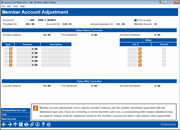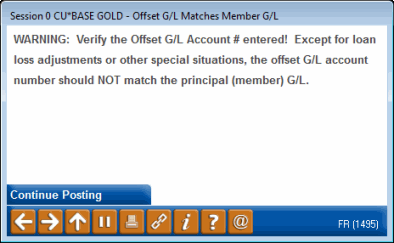Member Account Adjustment - Full (2)
| Screen ID: |
TECTBN-05 |

|
| Screen Title: |
Member Account Adjustment |
|
| Panel ID: |
5253 |
|
| Tool Number: | 492 | |
| Click here to magnify |
Access this screen by entering an account and using Enter on the previous screen.
Helpful Resources
Learn how to perform a full member account adjustment.
Learn how to perform a coded member account adjustments.
Learn how to configure account adjustment posting codes.
Screen Overview
This second screen is used to make adjustments to a member's account and an offsetting G/L account. There are two formats to this screen: one for loans and the other for share and certificate accounts.
-
NOTE: This is the “full” account adjustment system where the user must manually enter G/L offset account information. Learn more about the Coded Account Adjustment system where codes containing G/L information can be configured for common types of adjustments
The “Current Status Before Correction” section shows balance information about the account as it stands before any adjustment is posted. The “After Correction” section at the bottom of the screen will update to show the result of any adjustment entered on the screen (use Enter to see these totals update).
Up to five different adjustment transactions can be entered using the fields in the middle of the screen. (See below for descriptions of all entry fields.) Use Enter at any time to update the resulting totals and verify the amounts entered. When all entries are complete, use Post to post the adjustment(s) to the member's account and the G/L and return to the initial screen.
Special note if reversing a check posted to the wrong account
Special note if reversing an NSF check or NSF fee
Important Notes
-
This screen requires a thorough knowledge of the impact of all changes to the G/L. Often, it is necessary to perform a series of inquiries about a member's account to obtain all necessary information before attempting the adjustment. Also, it may be necessary to block the adjustments from printing on a member's statement (click for more details).
-
Member account adjustments correct only the member's balance and the member information associated with the adjustment type code. If you are correcting a current day teller cash error, a corresponding teller drawer adjustment may be required. Always verify the adjustment results for the member's account and teller's cash balance when appropriate. (If you are adjusting a loan and it recalculates payments interactively on disbursement, it is recommended that you use the loan disbursement tool (Tool #50) as the account adjustment tool will not recalculate the payment. If move forward with account adjustment for the disbursement, you will need to manually review the loan.)
-
If the G/L offset account number entered matches the member G/L account number displayed at the top of the screen, the following warning message will appear:

Although the warning does not prevent you from posting this way (because there will occasionally be legitimate reasons to do so), it does provide a warning that should prevent someone from doing it by accident.
-
If manually posting an ACH exception item, after posting you may wish to use Update Transaction Desc/Stat feature Tool #918 Update Transaction Desc & IRA/HSA Post Codes (Shortcut: desc). to manually enter any secondary transaction information that was on the original ACH item, particularly for POP transactions.
-
Special note on making adjustments to online credit cards: For instructions on the unique characteristics of adjustments made to online credit card loans, including examples of typical adjustments, refer to the Online Credit Card Processing User Guide' booklet.
-
Special note on adjustments to delinquent loans: Remember that the delinquency monitoring system ignores any loans with a current balance of $0 (or below), regardless of whether there is accrued interest on the account or not. So if you are working out a payoff arrangement with a delinquent member and wish to pay off the loan via an account adjustment, it is imperative that you not only pay down the loan’s principal, but that you also clear out any accrued interest from the account. Make sure to verify that accrued interest shows $0 after the adjustment, and watch to make sure the loan actually closes at the end of the day, if appropriate.
-
If you are getting the error “0141- Transaction amount would exceed disbursement limit” you will need to temporarily increase the disbursement limit in Tool #20 Update Account Information. This limit increase will need to cover the Loan balance+adjustment amount. For example if the loan balance is $4,200, and you need to make a $300 adjustment, the disbursement limit needs to be temporarily adjusted to $4,500. Once you have completed the adjustment, make sure to change the disbursement limit back to it’s original amount.
Field Descriptions
|
Field Name |
Description |
|
Type |
Enter
a valid transaction type code, either debit or credit. Click the
lookup button |
|
Amount |
Enter the total amount of the adjustment. |
|
Description |
Enter a description to describe the adjustment transaction (required). |
|
IRA/HSA |
(Appears for share accounts only.) Use this field to enter a valid IRA or HSA code. |
|
Interest |
(Appears for loan accounts only.) Use this field to enter which portion of the adjustment amount should be applied against accrued interest due. (If the adjustment is entirely a refund of interest, this amount will match the amount entered into the Amount field.) |
|
Principal |
(Appears for loan accounts only.) This is a calculated field representing the total adjustment that will be made to the principal balance on the loan account; after entering the adjustment amount and any interest adjustment, use Enter to calculate this amount as follows: Amount - Interest = Principal |
|
Charge Type |
These columns appear only on the screen used for adjusting online credit card loan accounts. Refer to the Online Credit Card Processing User Guide booklet for details. |
|
Apply As |
This column appears only on the screen used for adjusting online credit card loan accounts. Refer to the Online Credit Card Processing User Guide booklet for details. |
|
Offset G/L Account |
The G/L account number to be offset by the adjustment. Except in very rare cases, this should NOT match the member G/L shown at the top of the screen. |
|
Offset G/L Br/Loc |
The branch number (for credit unions which use branch level accounting) which will be offset by the adjustment. This should match the branch number listed at the top of the screen next to the member name. |
|
Additional Fields Specific to Loan Account Adjustments: The following four fields can be used to adjust the delinquency fine totals and last payment information on the member loan account.
Changes made to these four fields will be recorded in the File Maintenance log and can be reviewed using the “CU File Maintenance Review” (Tool #159: Audit CU File Maintenance (CUFMAINT). |
|
|
Delinquent fine YTD amount |
(Appears for loan accounts only.) Use this field to enter the amount of year-to-date delinquent fines paid to be recorded on the loan account.
|
|
Delinquent fine amount |
(Appears for loan accounts only.) Use this field to enter the amount of delinquent fines due to be recorded on the loan account.
|
|
Last payment amount |
(Appears for loan accounts only.) Use this field to enter the amount of the last payment made to this loan, to be recorded on the loan account.
|
|
Last payment date |
(Appears for loan accounts only.) Use this field to enter the date of the last payment made to this loan, to be recorded on the loan account.
|
Buttons
|
Button |
Description |
|
Use this key to display the CU*BASE Math Calculator window, used for calculating the amount of dividends or interest based on a balance, rate, and specific number of days. For example, this would be helpful if you needed to determine the interest correction on an NSF loan payment if the payment was reversed a week after it was posted. |
|
|
Post |
To post all adjustments and return to the Home Page. |
|
New Account |
To clear all adjustments and enter a different member account number. |
 to see
a listing of codes, or refer to the following help topic:
to see
a listing of codes, or refer to the following help topic: